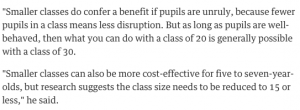‘The year 9 class of the future?’
A discussion around class size is never far away from educational debate. Every so often a new report is emblazoned with headlines in the press: ‘class size matters’…’class size doesn’t matter‘. What are we to believe? Well, of course class size matters, stupid. And yet, as with most things in education, it is more complicated than that.
The debate has broken out once more on social media, based on a review of class size research undertaken by Diane Whitmore Schanzenbach, called ‘Does Class Size Matter‘, resulting in headlines in established media outlets like the Washington Post: ‘Class Size Matters a Lot, Research Shows‘. Interestingly, this research summary is over a year old, but the debate that were initiated back in February 2014 are being repeated once more. In fact, the evidence stated by Schanzenbach is broadly the same as what has been offered by the EEF Toolkit, but Schanzenbach doesn’t really discuss potential alternatives approaches, nor the issues that attend class size reduction.
Now, you would be hard pressed to find a parent, teacher or student, who would demand larger class sizes. I am a parent and I am a teacher. Do I prefer groups of 20 over groups of 25, for example? Of course – it would be my preference almost every time to have 20 students. Only, the issue with reducing class size like this is that it doesn’t transform student outcomes – it is no silver bullet. I wouldn’t change my practice with the class size reduction I describe.
Does class size matter? Of course – but not as much as we think and we seldom give a thought to other factors that attend class size reductions.We need to ask better questions.
First, how big a class size reduction are we taking about? The impact on student outcomes will likely correlate with how big a reduction. If we have a class of 30 reduced to 25, then the impact will be relatively small, if there is any at all. We like to think that teacher interactions are transformed and time on task and the quality of feedback all improves with a smaller class, but the reality is that teacher quality is rather stable – therefore a not-so-great teacher with 30 students will not be transformed by having five fewer.
If we are saying the class size reduction is from 30 students to 15 students then we are definitely getting somewhere. The evidence suggests that it could have a very positive impact, especially for younger children and minorities.
Again, though, we miss the crucial support factors. Is the teacher changing their practice appropriately with the smaller group? Are they giving better personalised feedback, eliciting greater trust and generated more focused time on task? Or do we have a little less stress (no doubt important too)? If teacher training isn’t prioritised then there may be no change regardless of class size.
We then bump into more complex problems. As Dylan Wiliam states, the policy reduce class size doesn’t come cheap:

Not only are the costs significant (no doubt prohibitive in our generation of declining budgets to pay for banker-induced debts) but that isn’t the only problem. Large scale class size approaches in Tennessee and California exposed a hidden issue: if you reduce class sizes then you need many more teachers.
Teachers don’t grow on trees, so needing more teachers could mean a lowering of standards, if we can get the requisite teachers at all. If we cannot get more teachers (our current recruitment and retention crisis is chastening) then we would likely begin to have fewer high quality teachers in front of our students. The gains offered by the class size reduction could be washed away in this scenario.
I want my children to have a great teacher in front of them first and foremost. I would rather a better teacher in a larger class. In the best of all possible worlds, we would have both, but that is not our current predicament.
Don’t misunderstand me, I don’t want my children having a Science lesson Skyped to them by a teacher from Northampton in a hall stuffed full with 60 students. I reject the absurd notion that class size doesn’t matter at all, but we need to recognise that reducing class size is not a silver bullet.






Comments